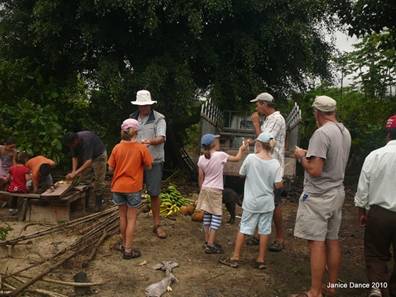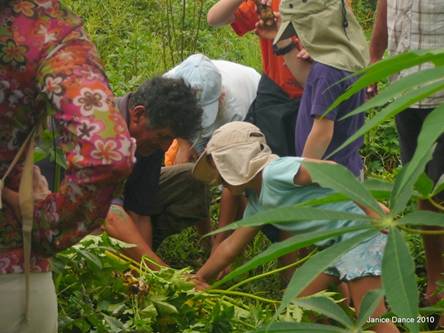Omero's Farm - (30)

|
09.00am Sunday morning saw our happy band of sailors gathered on the jetty for our trip to the farm. Luis has a cousin who has a farm up in the highlands and we thought it might be a nice trip to see life as the locals live it, see some of the countryside as well as buying fresh fruit and vegetables. The numbers were smaller this time, but the atmosphere was as charged as for the rodeo as we piled onto the back of the truck. We climbed higher this time, up into the clouds. The higher we got the more fruit trees we saw. There were bananas, papayas, oranges, which you had to duck to avoid and pineapples growing in the fields along the roadside. The truck pulled off the road onto a small, very bumpy and wet, dirt track. We had arrived.
Omero and his family greeted us and Luis gave us details
of the background of the farm. Omero had lived on mainland As he had family on Isabela, he gathered up his family, got some seeds and relocated to Isabela. That was 8 years ago and in that time he had built a home and planted and farmed the hectare of land which was his farm. He is the only vegetable farmer on the island and has been teaching locals how to grow vegetables. Fruit has always been abundant, but vegetables require more work and knowledge. He works the farm with 2 helpers and there is a lot of work to do. He has 3 pineapple plantations, one 5 years old, another 3 years and the third 2years. The soil is very fertile and made me green with envy when I compared it to the clay we have back at home.
He took us through his banana plantation, where he grows several different types, the small sweet ‘lady finger’ or ‘sugar’ bananas, green bananas and plantain. He explained how once the plant has fruited, it will not fruit again, so you don’t cut away the new growth as that is your next fruit stock. All of this is useful information for me as we have just planted bananas at home. Then we made our way to the pineapple plantation. These pineapples had been growing 5 years. He showed us how to make new plants and care for the pineapples in order to get better fruit (which was interesting for me as I have planted 2 pineapple plants at home) As we walked through the vegetation we got a bonus we didn’t expect. We all had a crash course in dancing ‘the Ecuador Salsa’. The ants here are voracious and were everywhere (including up my trouser leg!!!), we didn’t need telling twice to hurry along! We were shown his hot houses, where he was growing peppers and tomatoes ( he would hand the children freshly picked samples to try as we went). All of his produce was organic except for the white carrots, which he used a mild insecticide, which was allowed as it was a natural one.
They also had pigs and chickens on the farm.
The chicken were not free range, instead they were in enclosures. When I asked what preyed on them, I was told it was the Galapagos Hawk, which of course is a protected species!
He then took us up to the house, where were we invited in by his wife, Efiginia ( the same as Mrs Doubtfire!!!) and his daughter Rosia. Rosia is the baby of the family, being the youngest of 9! Plates of pineapple, papaya and bananas were brought out for everyone to share. The pineapple was delicious, it was almost white, but so juicy and sweet. I don’t believe I have tasted one as nice. The children were shown the new kittens and chicks and then Luis’s son, showed them how to grind the corn to feed the chickens. They all took turns grinding the corn, before trooping off the feed the chickens. It was great to see the children interested getting involved. We talked with Efiginia and Rosia, who was about to study English, so was getting in some practice. Rosia lives on Sta Cruz, but was over with her daughter for the festival.
Omero went and picked the produce we wanted, together with some sugarcane for the children. He took the time and effort to cut the cane and pretty soon all the children (big and small) were sucking on chunks of sugar cane. Omero was a wonderfully warm and generous spirited person.
He took time to explain things to us, despite the language barriers. He also made time for the children. He took them to dig up carrots, then to cut sugar cane and then took the time to prepare it for them. I for one, felt we had been priviledged to have been welcomed so readily. At least one among us thought that they we shouldn’t have to pay for the transport to go and buy his produce, instead ‘he should have paid us’. I feel sorry for them, as they totally missed the point of the whole ‘adventure’ and it clearly illustrated the difference between a selfish and a generous spirit, such as Omero’s. When it came time for us to go, we thanked him for allowing us to visit his farm and I was surprised when he took my hand and thanked us for taking he time to come and visit. Such a genuine, heart felt statement, it was quite touching, especially as I knew I had nothing to do with us buying his fruit and veg, as he supplies all the stores and restaurants on the island. No, I think he took great pleasure in sharing his passion for farming, with people who were genuinely interested and showing us what he had achieved. Efiginia also made it clear she had enjoyed meeting us all and showing us her home. When you think about how they came to be here, they had every right to be proud of what they had achieved. Each of the children went to say thank you and goodbye and then we all piled back it onto the truck and headed back to town. Everyone stayed in town to enjoy a leisurely lunch before
heading back to their respective boats. Once again, a great side tour for $5 a boat. Tomorrow is the big day, the trip to the volcano, Sierra Negra. Luis had done us proud. He had spent four hours with us and had only charged us $30. When you compare that to the $300 we had to pay for a boat for a couple of hours more, I think we got a very good deal indeed. |

 We followed him through his vegetable garden, planted
with rows of white carrot, white and red onions, runner beans, parsley and
spring onions. All of which had been ploughed with a primitive, but obviously
effective plough, which was pulled by their donkey.
We followed him through his vegetable garden, planted
with rows of white carrot, white and red onions, runner beans, parsley and
spring onions. All of which had been ploughed with a primitive, but obviously
effective plough, which was pulled by their donkey.


